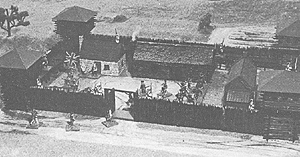 The French and Indian wars is the theme topic for The Courier's Volume VIII. Though one could go back to the 1690s for early phases of this era, I have chosen the three military conflicts of the mid 18th Century as our basis of discussion because of common weapons, uniforms, circumstances, and leaders. The first war occurred between 1744 and 1748 and was known in North America as King George's War.
The French and Indian wars is the theme topic for The Courier's Volume VIII. Though one could go back to the 1690s for early phases of this era, I have chosen the three military conflicts of the mid 18th Century as our basis of discussion because of common weapons, uniforms, circumstances, and leaders. The first war occurred between 1744 and 1748 and was known in North America as King George's War.
Militia are parading at a model of a British frontier stockade from the collection of Bill Protz. Miniatures are 30mm Willies and Staddens. The fort was scratch-built out of matchsticks by Hal Thinglum. Photo by Bill Kojis.
In Europe it was called The War of Austrian Succession. A second conflict began in 1754 which ended in 1760. In the United States it is nowcommonly referred to asThe French and Indian War while Canadians refer to it as The Seven Year's War in North America. (The Seven Years'War 1756-1763 isthe appellation for that part of the same war confined to Europe.) One could also call it The Great War for Empire. At the time, British Americans called it The French War. Finally, there was a third upheaval between 1763 and 1766 called Pontiac's Rebellion. Later articles will individually discuss these three wars. Meanwhile, the briefest outline of occurrences in each is appropriate at this time.
During King George's War 1744-1748, action centered on military escapades in Nova Scotia and Isle Royale (Cape Breton Island in eastern Canada). In 1744 the French overwhelmed Canso. A year later a Yankee Army of ill-trained provincials seconded by a British fleet amazingly conquered the largest fortress in North America, Louisbourg. Meanwhile, the frontier was subjected to many a French-Indian raid.
The French and Indian War 1754-1760 was the busiest of the three wars and saw enormous numbers of combatants take up arms in the three theaters. At first the French were able to hold off the rising tide of British and American numbers by skillful maneuver and even win some meaningful victories such as the battles of Fort Necessity in 1754, The Monongahela in 1755, Fort Bull and Oswego in 1756, Fort William Henry in 1757 and the Heights of Carillon in 1758. However, by the end of 1758 with the fall of Louisbourg and Forts Frontenac and Duquesne, it was clear that defeat was inevitable. In 1759 the British drive to the center of Canada was unstoppable as was proven by the fall of Quebec and Forts Carillon,
St. Frederic and Niagara. The loss of the latter severed the supply link to the Ohio causing disaster for French garrisons and interests there. In 1760 Montreal capitulated and with it ownership of New France passed to the British.
Pontiac's Rebellion 1763-1766 was borne out of Indian mistrust of the British and Americans, because the latter were expected to never cease encroachment of Indian land and because the Indians had a hope that the French, whom they preferred, would return. An unusual Indian alliance was formed and many western frontier posts fell. The alarm was so great that the frontier was rolled back in a wave of panic and terror as settlers and frontiersmen fled to the coasts. However, the Indians eventually came to realize that the French were not returning and that the British and Americans were too powerful to be beaten. The war sputtered to an end once regulars assembled and marched to break Indian power.
In the course of Volume Vill, various articles will be presented to acquaint readers with events, tactics, uniforms, organization and wargame ideas relating to this era. A body of nearly two dozen enthusiasts (and more I hope) have volunteered to make written contributions. Additionally, on the retail scene there is an exciting new array of miniatures, buildings and warships available in a variety of scales. Though published rules specifically germane to the period are scarce, it is my hope that by the end of the theme year, many new and stimulating systems, plus campaign ideas, will make their debut.
More French and Indian Wars: 1744-1766
-
Introduction
Historical and Geographic Setting
Campaigning, Tactics, and Historical Importance
Why Wargame the Era: Opinions
Map: Area of Operations (Large: 62K)
Map: Area of Operations (Jumbo: slow: 196K)
Bill Protz jr Bio: Theme Editor
Back to Table of Contents -- Courier Vol. VIII No. 1
To Courier List of Issues
To MagWeb Master Magazine List
© Copyright 1987 by The Courier Publishing Company.
This article appears in MagWeb (Magazine Web) on the Internet World Wide Web.
Other military history articles and gaming articles are available at http://www.magweb.com